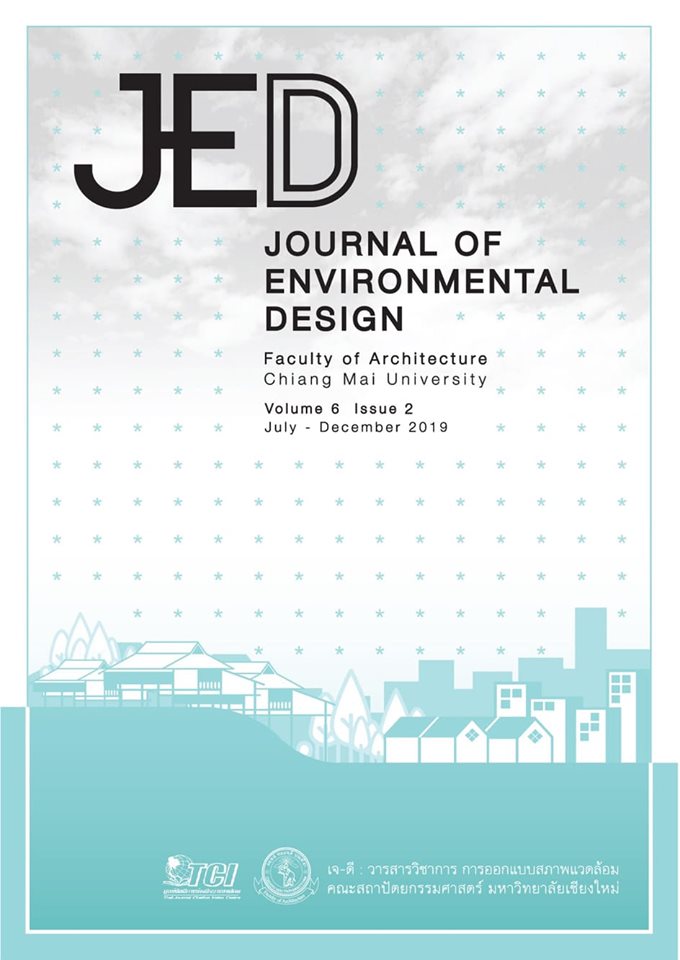การจัดการพื้นที่ตามแนวทางโคเฮ้าส์ซิ่ง เพื่อผู้สูงอายุของชุมชนศรีโคตรบูรณ์อโศก
Main Article Content
บทคัดย่อ
จากสถานการณ์ของประเทศไทยที่กำลังก้าวเข้าสู่สังคมผู้สูงอายุ การพัฒนาที่อยู่อาศัยร่วมกันในรูปแบบของโคเฮ้าส์ซิ่ง สำหรับส่งเสริมคุณภาพชีวิตผู้สูงอายุ เป็นแนวคิดหนึ่งซึ่งสามารถนำมาปรับใช้แต่การอยู่อาศัยในโครงการแบบโคเฮ้าส์ซิ่งยังประสบปัญหาเรื่องการจัดการพื้นที่ส่วนกลาง การขาดความเป็นส่วนตัวและการดูแลรักษาความเป็นระเบียบเรียบร้อยของพื้นที่ บทความนี้มีวัตถุประสงค์เพื่อนำเสนอกรณีศึกษาของชุมชนศรีโคตรบูรณ์อโศก จังหวัดนครพนม ซึ่งมีการจัดการพื้นที่ชุมชนตามแนวคิดแบบโคเฮ้าส์ซิ่ง โดยมีสมาชิกเป็นผู้สูงอายุ มีการอยู่อาศัยและทำกิจกรรมในพื้นที่ส่วนกลางร่วมกัน ภายใต้แนวคิดวิถีชีวิตแบบพอเพียง และหลักพุทธเศรษฐศาสตร์ ผลจากการศึกษาพบว่า ชุมชนมีลักษณะการวางผังชุมชนในระบบตารางและออกแบบให้อาคารมีการเกาะกลุ่ม ทำให้เกิดความสะดวกสำหรับผู้สูงอายุในการสัญจรไปยังพื้นที่ต่างๆ การวางผังทำให้เกิดพื้นที่ระหว่างอาคารที่ถูกใช้เป็นพื้นที่อเนกประสงค์ที่ช่วยสนับสนุนกิจกรรมการผลิตของผู้สูงอายุ นอกจากนี้ ลักษณะบ้านเรือนและการจัดการพื้นที่ทำให้เกิดความสามารถในการปรับเปลี่ยนรูปแบบการใช้งานในแต่ละช่วงเวลาได้ ส่งผลให้เกิดความสมดุลระหว่างความเป็นสาธารณะกับความเป็นส่วนตัวและการดูแลรักษาพื้นที่ ในขณะเดียวกันยังสามารถสร้างความอุ่นใจ และความรู้สึกปลอดภัยให้แก่สมาชิกในชุมชนได้อีกด้วย
Article Details
เอกสารอ้างอิง
Brown, S. L. (2002). Intentional community: an anthropological perspective. New York: State University of New York Press.
Choutridsanawong, K., et al. (2014). Karn prayuk naewkid setthakit choeng sangsan phuea tham karn kaset su karn phueng ton eng yang yangyuen phai tai kwam phophiang khong chumchon pathom Asoke. (In Thai). [Applying the creative economy theory to sustainable agriculture based on self-sufficiency economy of Patom-Asok community]. Veridian E-Journal, 7 (1), 100-110.
Chula Unisearch, Chulalongkorn University. (2017). Khrongkarn karn sueksa rubbab karn hai borikan lae karn chatkarn teephak samrab phu suang-ayu .(In Thai). [Study of administration and management of residence for older persons]. Retrieved January 20, 2019, from https://www.dop.go.th/download/knowledge/th1512636145-109_5.pdf
Meltzer, G. (2005). Sustainable community: learning from the Co-housing model. Bloomington: Trafford Publishing.
Nachaiwieng, P. (2014, May 4). Interview. Village scholar and coordinator of Sri Khotraboon Asoke community.
Phanusittikon, P. (2012). Karn pattana khrongkarn teeyu asai bab Co-housing: koranee sueksa khrongkarn Bandeawkan. (In Thai). [Co-housing development: a case study of Bandeawkan project]. (Master’s thesis). Bangkok: Chulalongkorn University.
Pinijvarasin, W. (2003). Experience of well-being in Thai vernacular houses. (Doctoral dissertation). Parkville: The University of Melbourne.
Pinijvarasin, W. (2016). Karn songsoem khunkha thongthin lae kwam khemkhaeng khong chumchon phan karn prubprung phumithat chumchon. (In Thai) [Encouraging local values and strengthened community through local landscape development]. Journal of Environmental Management , 12 (2), 64-81.
Riengwattanasuk, S. (1987). Chitwithaya sangkhom. (In Thai) [Social Psychology]. Bangkok: Ramkhamhaeng University Press.
Schacher, C. (2006). The good and the bad of Co-housing. Retrieved September 13, 2018, from https://ala-apa.org/newsletter/2006/10/17/the-good-and-the-bad-of-cohousing/
Sirikanchana, P. (1998). Samnak Santi Asok: kwam penma lae botbat tang sartsana nai sangkhom Thai. (In Thai) [Santi Asoka : its development and religious roles in Thai society]. Retrieved January 21, 2019, from https://www.cubs.chula.ac.th/old/images/research/57_7/SantiAsoka.pdf
Siriraksophon, B. (2016). Bun niyom: chariyatham tang setthakit kub karn khap khluean tang sangkhom khong chao Asok. (In Thai) [Booniyom: Asoka’s economic ethics and social movements]. (Master’s thesis). Pathumthani: Thammasat University.
Sommat, P. (2009). Kwam rusuek plotphai nai phuentee satharana: sueksa nueaha saphawa pen suantua lae karn yu ruam kan nai phuentee satharana. (In Thai). [The making degree of privacy space in public] (Master’s thesis). Bangkok: Silpakorn University.
Sri Khotraboon Asoke community. (1998). Ekkasan nænam chumchon Sri Khotraboon Asoke. (In Thai) [Introduction document of Srikhotraboon Asoke]. Nakhon Phanom: n.p.
Thongon, K. (2010). Karn pattana khrongkarn teeyu asai Intentional community: koranee sueksa khrongkarn Bann Munkong. (In Thai). [The development of intentional residential community: case studies of Bann Munkong housing project, Bangkok metropolitan area] (Master’s thesis). Bangkok: Chulalongkorn University.


